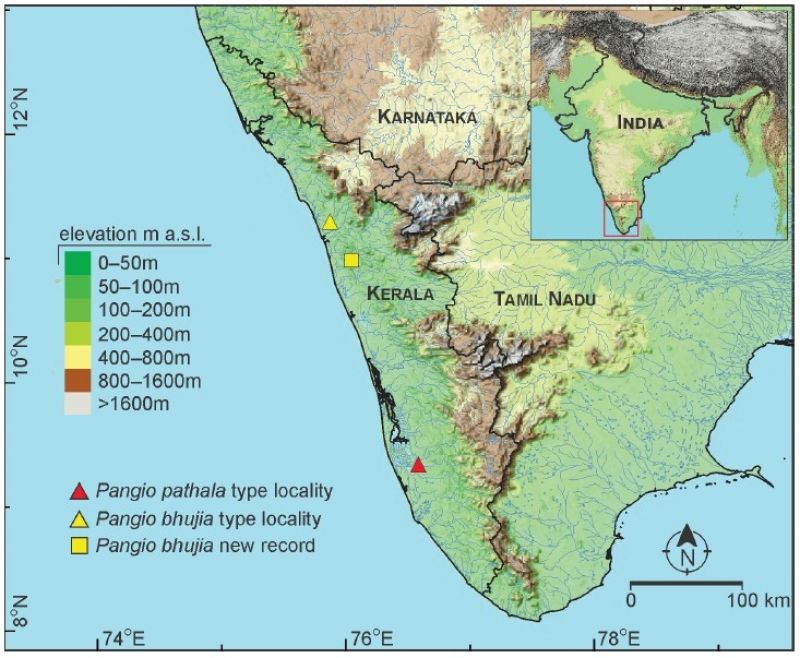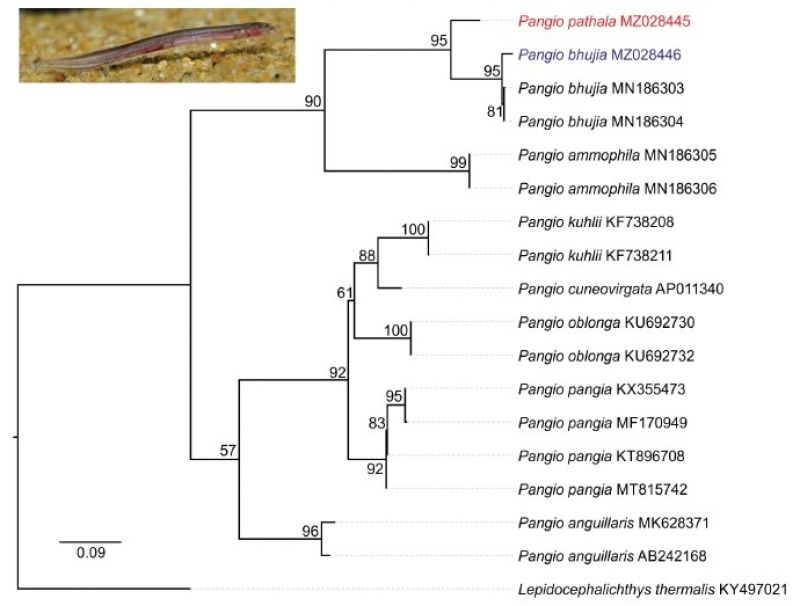Pangio bhujia
Anoop, Britz, Arjun, Dahanukar and Raghavan 2019

| ORDER | SUB-ORDER | FAMILY |
|---|---|---|
| Cypriniformes | Cobitoidei | Cobitidae |
Synonyms
None.
Country
IndiaTypes
Holotype: BNHS FWF 980 25.4mm SL.
Paratypes: BNHS FWF 981-996 22.1mm-26.4mm SL.
Distribution
Type locality: a 6m deep well at Cherinjal, Kozhikode District, Kerala State, India (11°17’42”N, 75°52’7”E, altitude 40m).
Also known from: Indianoor (10°58’56.20”N, 76°2’32.51”E, 37 m. asl) near the town of Kottakkal, India (Sundar et al. 2022), which is 40km south of the type locality.
Habitat
In common with other subterranean fishes in the area (Horaglanis krishnai, H. alikunhii, H. abdulkalami, Kryptoglanis shajii, Kryptoglanis undet, Rakthamichthys indicus, R. roseni, R. digressus and Aenigmachanna gollum) this species probably inhabits very small openings within the laterite aquifer. These are probably of the order of 5-10cm maximum diameter though there may well me many kilometers of tunnels overall. Animals are only seen, and sampled, via man-made well used for water-supply purposes.
Systematics
The two subterranean Pangio species are each others sister species (see below). Britz, Ali and Raghavan 2012 described Pangio ammophila from the Western Ghats. A phylogenetic tree of the genus Pangio, based on mitochondrial co1 gene, given in Sundar et al. (2022) shows that P. ammophila is the sister species to a clade composed of the two subterranean Pangio species, P. bhujia and P. pathala. It seems very likley that either P. ammophila is the direct ancestor of both subterranen species, or that all three of these are derived from a fourth, so far unknown, species.
Biological Notes
Pangio bhujia appears to be a relatively long evolved troglomorph. It has little or no pigment, tiny eyes covered with skin, and a further, and not often seen troglomorphic character, of relatively very big eggs.
Eyes greatly reduced, pigment greatly reduced (GR/GR phenotype of Farley (2021), see also Metadata section for more details of this classification).
Conservation Status
[NE]
Museum Holdings
As above only.
Internet Resources
P. bhujia Genbank COI
P. bhujia Genbank COI
P. bhujia Genbank COI
P. pathala Genbank COI
P. ammophila Genbank COI
P. ammophila Genbank COI
Key References
- Biju, S.D. and Bossuyt, F. (2003)
- Bossuyt, F., Meegaskumbura, M., Beenaerts, N., Gower, D.J., Pethiyagoda, R., Roelants, K., Mannaert, A., Wilkinson, M., Bahir, M.M., Manamendra-Arachchi, K., Ng, P.K.L., Schneider, C.K., Oommen, O.V. and Milinkovitch, M.C. (2004)
- Roelants, K., Jiang, J. and Bossuyt, F. (2004)
- Gunawardene, N.R. et al. (2007)
- Bohlen, J., Šlechtová, V., Tan, H.H. and Britz, R. (2011)
- Britz, R., Ali, A. and Raghavan, R. (2012)
- Varma, A. (2017)
- De Grave, S., Arjun, C.P. and Raghavan, R. (2018)
- Anoop, V.K., Britz, R., Arjun, C.P., Dahanukar, N. and Raghavan, R. (2019)
- Britz, R., Anoop, V.K., Dahanukar, H. and Raghavan, R. (2019)
- Sidharthan, A., Raghavan, R., Anoop, V.K., Philip. S. and Dahanukar, N. (2020)
- Britz, R., Dahanukar, N., Anoop, V.K., Philip, S., Clark, B., Raghavan, R. and Rüber, L. (2020)
- Raghavan, R., Britz, R. and Dahanukar, N. (2021)
- Sundar, R.L., Arjun, C.P., Sidharthan, A., Dahanukar, N. and Raghavan, R. (2022)
| Biju, S.D. and Bossuyt, F. | Journal Article | 2003 | New frog family from India reveals an ancient biogeographical link with the Seychelles |
| Bossuyt, F., Meegaskumbura, M., Beenaerts, N., Gower, D.J., Pethiyagoda, R., Roelants, K., Mannaert, A., Wilkinson, M., Bahir, M.M., Manamendra-Arachchi, K., Ng, P.K.L., Schneider, C.K., Oommen, O.V. and Milinkovitch, M.C. | Journal Article | 2004 | Local endemism within the Western Ghats-Sri Lanka biodiversity hotspot |
| Roelants, K., Jiang, J. and Bossuyt, F. | Journal Article | 2004 | Endemic ranid (Amphibia: Anura) genera in southern mountain ranges of the Indian subcontinent represent ancient frog lineages: evidence from molecular data |
| Gunawardene, N.R. et al. | Journal Article | 2007 | A brief overview of the Western Ghats-Sri Lanka biodiversity hotspot |
| Bohlen, J., Šlechtová, V., Tan, H.H. and Britz, R. | Journal Article | 2011 | Phylogeny of the Southeast Asian freshwater fish genus Pangio (Cypriniformes; Cobitidae) |
| Britz, R., Ali, A. and Raghavan, R. | Journal Article | 2012 | Pangio ammophila, a new species of eel-loach from Karnataka, southern India (Teleostei: Cypriniformes: Cobitidae) |
| Varma, A. | Book | 2017 | Groundwater resource and governance in Kerala: status issues and prospects |
| De Grave, S., Arjun, C.P. and Raghavan, R. | Journal Article | 2018 | The discovery of Euryrhynchidae (Crustacea: Decapoda) in India, with the description of a new genus and species |
| Anoop, V.K., Britz, R., Arjun, C.P., Dahanukar, N. and Raghavan, R. | Journal Article | 2019 | Pangio bhujia, a new, peculiar species of miniature subterranean eel loach lacking dorsal and pelvic fins from India (Teleostei: Cobitidae) |
| Britz, R., Anoop, V.K., Dahanukar, H. and Raghavan, R. | Journal Article | 2019 | The subterranean Aenigmachanna gollum, a new genus and species of snakehead (Teleostei: Channidae) from Kerala, India |
| Sidharthan, A., Raghavan, R., Anoop, V.K., Philip. S. and Dahanukar, N. | Journal Article | 2020 | Riddle on the riffle: Miocene diversification and biogeography of endemic mountain loaches in the Western Ghats biodiversity hotspot |
| Britz, R., Dahanukar, N., Anoop, V.K., Philip, S., Clark, B., Raghavan, R. and Rüber, L. | Journal Article | 2020 | Aenigmachannidae, a new family of snakehead fishes (Teleostei: Channoidei) from subterranean waters of South India |
| Raghavan, R., Britz, R. and Dahanukar, N. | Journal Article | 2021 | Poor groundwater governance threatens ancient subterranean fishes |
| Sundar, R.L., Arjun, C.P., Sidharthan, A., Dahanukar, N. and Raghavan, R. | Journal Article | 2022 | A new diminutive subterranean eel loach species of the genus Pangio (Teleostei: Cobitidae) from Southern India |

